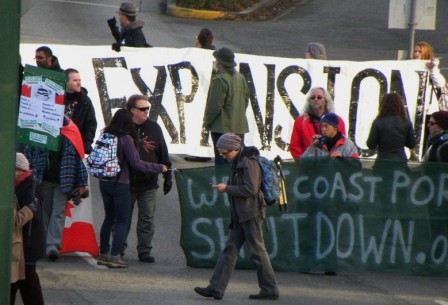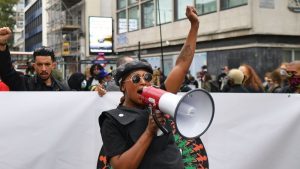
Posted on 07 March 2012 by danps
This was published with considerable feedback from several bloggers at Corrente: DCblogger, affinis, lambert and okanogen. My sincere thanks to all of them for their help.
Occupy has seemed to be in a bit of a winter hibernation. There are still encampments, meetings, decisions, protests, and so on, but it seems like there has been a relative lull in its activity level. This is fine; you can’t stay cranked all the way up to 10 all the time. A little pause to regroup, rethink and recharge is a good thing. There is a chance that the some occupations that emerge might have a very different character than the one that began to recede from public consciousness towards the end of last year, though.
Some recent developments have prompted me to refer back to my experience with the No on SB5/Issue 2 campaign in Ohio last year. For instance, there was tremendous outreach by supporters and organizers to the general population, and the umbrella group We Are Ohio went to great lengths to accommodate anyone who showed an interest in being part of the effort. Those who could only participate on a limited basis were given the opportunity. Whether it was a walk list for education or phone banking for those who couldn’t get around so easily, anyone who wanted to help was found a way to do so in whatever capacity they could. A low barrier to entry is very mass movement friendly.
The fact that SB5 centered around an issue and not a candidate made it very different from the usual election year political campaign, too. On the surface it might not have looked much different from a Vote For Me effort; the logistics of mounting it, connecting with voters, and turning out support were all probably lifted from some strategist’s playbook. But the spirit animating it was very different. It SB5 was driven by those who cared most about the issue, with elected officials generally falling in behind. As a direct democracy action it gave citizens the chance to work for an issue they cared about and, if successful, vote on the issue in the next election.
Putting together an effort like that (and winning, of course – which we did) is far more satisfying than working to elect someone who, given the labyrinth any proposal usually must travel to become enacted, will at best be able to offer the change and whip up support for it. That kind of open, issue-oriented campaign is not just a template for other direct ballot actions like tax hikes on the rich or card check for union membership (to name just two issues that have been paid extravagant lip service by politicians and somehow – darn the luck! – continue to resist being enacted anywhere). It is something activists in general could learn a lot from.
For instance, in the last week or so the issue of transparency at Occupy has become very contentious. Perhaps the most prominent examples have been in Chicago and Oakland. Occupy Chicago adopted a resolution that sharply limits streaming of the General Assembly, and a number of folks there voiced their disappointment, perhaps none more than occupiechicago. Meanwhile in Oakland a proposal for what was called a “principle of solidarity” called for, among other things, not posting “potentially incriminating video footage or photos of our comrades.”1 This was described by Kit O’Connell as a security culture meme, while Jasper Gregory correctly noted it was a “self-censorship proposal” and its “logic would lead to total social media boycott.”
Now, you could say: Disagreements happen, sometimes you win, sometimes you lose. The proposal was submitted through the General Assembly process and passed2. That’s how the process works.
However, this disagreement goes directly to the heart of Occupy’s ability to keep and attract participants. Lack of transparency leads to information asymmetry; those who are able to hoard information gain a large and artificial advantage over those who don’t.3 As occupiechicago put it: “Livestreaming forces people to be accountable and weeds out infiltrators. Why would we allow people to make a decisions that affect our community without our community knowing who they are?”4 The degree to which Occupy is visible is the degree to which it has the potential to be a mass movement. As the movement nears its six month mark it each occupation seems to be developing – in some areas, anyway – its own subculture. Some of these subcultures are familiar, too. While the initial exhilaration of a leaderless movement was driven by a deep disillusionment with leadership over the past decade or so, the current narrative seems to be transitioning to a much less contemporary one – and one with an abysmal track record.
Lack of transparency leads to lack of formal procedures, which in turn produces unstructured networks. Jo Freeman examined this dynamic in relation to the women’s liberation movement in the early 70s and noted: “The more Unstructured a group is, the more lacking it is in informal structures, and the more it adheres to an ideology of ‘structurelessness,’ the more vulnerable it is to being taken over by a group of political comrades.”5 Freeman’s article is long, but provides a thorough examination of related social and small group dynamics: The (impossible) claim of structurelessness, the rise of an unaccountable elite, the opacity of decision-making processes and the inevitable marginalization of the groups that embrace those qualities.
Freeman writing in 1972 may well be describing the coming future for Occupations that embrace elite privileging proposals like shutting down live streams:
The criteria of participation may differ from group to group, but the means of becoming a member of the informal elite if one meets those criteria are pretty much the same. The only main difference depends on whether one is in a group from the beginning, or joins it after it has begun. If involved from the beginning it is important to have as many of one’s personal friends as possible also join. If no one knows anyone else very well, then one must deliberately form friendships with a select number and establish the informal interaction patterns crucial to the creation of an informal structure. Once the informal patterns are formed they act to maintain themselves, and one of the most successful tactics of maintenance is to continuously recruit new people who “fit in.” One joins such an elite much the same way one pledges a sorority.6 If perceived as a potential addition, one is “rushed” by the members of the informal structure and eventually either dropped or initiated. If the sorority is not politically aware enough to actively engage in this process itself it can be started by the outsider pretty much the same way one joins any private club. Find a sponsor, i.e., pick some member of the elite who appears to be well respected within it, and actively cultivate that person’s friendship. Eventually, she will most likely bring you into the inner circle.
All of these procedures take time. So if one works full time or has a similar major commitment, it is usually impossible to join simply because there are not enough hours left to go to all the meetings and cultivate the personal relationship necessary to have a voice in the decision-making. That is why formal structures of decision making are a boon to the overworked person. Having an established process for decision-making ensures that everyone can participate in it to some extent.
Freeman’s structureless tyranny would produce two pernicious effects in Occupations where it takes root. First, the conformist and increasingly insular culture she describes ends up becoming more and more about charisma and force of personality. Charisma is a really rotten basis for making decisions, though. Demagogues will tend to have the most charisma, and they will tend to drive groups toward strategically ill-thought-out actions that reinforce their charisma. And given a lack of formal structure, there are no restrictions or checks and balances on their power. Without structure, the de facto leaders are unaccountable.
Which leads to the second problem. In the absence of structure, and with consensus decision making in large open GAs, meetings last forever and can make few decisions. That means that even separate from the time required to cultivate relationships and gain political capital – to be allowed into the “in” group – those with other commitments such as work or family are deprived of a way to meaningfully participate. Those who can’t sit through hours of meetings simply won’t have a vote. For occupations that adopt this model, barriers to participation are very high. The people who gain power in these situations are the most stubborn and the most militant. They’ll hold out forever, while everyone else goes home. Others either leave or capitulate (to get the meeting over with or live to fight another day).7
For as important as the Occupy encampments are, they total in the low thousands nationwide. In a country of 330 million that is a rounding error of a rounding error, and a movement that claims to champion all but the very richest has to find a way to connect to that much larger portion – the 99% of the 99%. Those with obligations that prevent full time participation or that have no convenient way to regularly visit Occupy need to have some way to connect to it. Making the activities of the camps as available as possible is a crucial part of scaling Occupy out to the whole country and all walks of life. (So is being receptive to feedback from outside the camp!)
Maybe some of the Occupiers arguing against transparency don’t much care for a mass movement. Maybe they like the direction Occupy is going and would very much like to take ownership of it (while maintaining the fiction that it is a leaderless movement, of course). That means those of us who want to see it continue as a mass movement and believe that Occupy belongs to all of the 99% have to raise our voices. We need to do our best to persuade everyone else that Occupy must be visible to all and available to all walks of life. It must, in short, embrace a radical openness.
Cross posted from Pruning Shears.
NOTES
We enact this principle of solidarity with one another by recognizing our individual and collective responsibility not to incriminate our fellow Occupiers, and hereby agree that:1) We will not talk to the police about our comrades (This includes all levels of local, state and federal law enforcement, jail staff, Immigration & Customs Enforcement, Internal Affairs, and the Citizens Police Review Board.).2) We will not post potentially incriminating information about our comrades on the internet and social media (This includes any forms of information posted on Facebook, Twitter, blogs, email, etc.).
3) We will not post potentially incriminating video footage or photos of our comrades (This includes being attentive to the fact that even minor and unintended incidences can be used as the basis for criminal prosecution.).
(Back)
2. Affinis, re: Chicago (via email):
Based on what’s on the forum, it’s not exactly a complete block. Stack lines can’t be streamed. There’s an “opt-in” where a speaker can consent to be streamed (and a speaker who opts-in will then stand in a specially marked “stream” zone while speaking). Based on a couple of the comments, there was an amendment so that a GA participant can ask for a complete GA blackout. The GA will then be blacked out and discuss whether to proceed with a full blackout for the entire proposal discussion/vote.
It seems that most OC GAs currently are not streamed. Even though the proposal is apparently not a complete prohibition on all streaming, with all these restrictions, I doubt anyone will bother to try to continue to stream (and any stream produced would be swiss cheese).
(Back)
3. Lambert, via email: “When a march is organized and the participants haven’t been told where they’re going, that’s information asymmetry.” An example of this from outside Occupy:
The problem is that the financial system has been allowed to get so complicated and so rigged in favor of the people with information, that normal people, including homeowners, credit card users, politicians, and regulators have been left in the dark, and many of the little guys are still stuck in ludicrous contracts left over from the outrageous securitizations that took place in the CDO market.
(Back)
After being giulted non stop about how i should not stream i set things up at Cermak so that people were comfortable. I also agreed with this proposal when it was presented, because the “dangers” of livestream were beaten into my head (not literaly…we are non violent).
Remember when we used to call ourselves a transparent movement? This proposal ensures that we are no longer a transparent movement. This allows people to make decisions about Occupy Chicago and not be held accountable. This allows people to hide… I will not hide things like our government does. Livestreaming forces people to be accountable and weeds out infiltrators. Why would we allow people to make a decisions that affect our community without our community knowing who they are? I urge people to vote NO on this tomorrow so that we can preserve the transparency of Occupy Chicago. I will present a counter proposal in the next couple days
(Back)
5. Note the similarity in language: Freeman describes the fellow feeling among the group taking control as that of comrades – and that word is repeatedly invoked in the OO principle of solidarity.
(Back)
6. In his book The Dark Side of the Left: Illiberal Egalitarianism in America Richard J. Ellis describes (p. 10) how Students for a Democratic Society [SDS] started as a genuinely democratic group and an unaccountable elite. (Note the use of “solidarity, comrade!” type bromides.)
Chapter 6 addresses a paradoxical development that is central to all radical egalitarian movements but that is particularly acute in the case of SDS. In the beginning, SDS was organized along fairly conventional parliamentary lines: majority rule, Robert’s Rules of Order, and national conventions that elected a president, vice president, and national executive committee. But as egalitarianism became increasingly strong within SDS, these representative structures were dismantled in the name of participatory democracy and antielitism. “No leaders, no structures” was the egalitarian theory; elitism and arbitrary, unaccountable power were increasingly the reality. At national conventions decision making by consensus replaced majority vote, which in practice stripped conventions of their decision-making capacity and thereby transferred decision-making power to the permanent National Office. Annual rotation in office for elected leaders meant concentrating power in the hands of unelected staff, a concentration of power that was furthered by the decision to abolish the offices of president and vice president. These “democratic” reforms produced a leadership that became steadily less accountable to the SDS membership, which in turn made it easier for the leadership to destroy remaining democratic forms. Reforms in the name of democracy produced less democracy; antielitism produced its opposite.
(Back)
7. Three secondary problems of structurelessness: When decisions get made, given structurelessness, there’s no way to enforce the decision. So democratic decisionmaking (as in making decisions that actually mean anything) is lost, and in practice power devolves to autonomous actors – particularly those actors who are the most charismatic (where others will follow their lead).
Also, the clubiness of the elite would cause individual Occupy encampments to become increasingly isolated from other ones. An idiosyncratic and personality-driven Occupy is an Occupy largely disconnected from the Occupy movement as a whole. While there’s much to be said for the model of independent nodes in activism, the implementation of the model matters. Having it in place and elaborated on from day one is not the same as an unarticulated drift into a cult of personality. Context matters.
Finally, loss of transparency leads to loss of potential corrective input and perspective. It’s the opposite of crowdsourcing. It basically cuts off the possibility of valuable “outside” input (e.g. someone recognizing a potential fatal flaw in a plan of action).
(Back)







